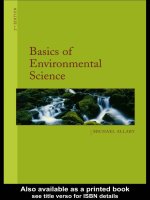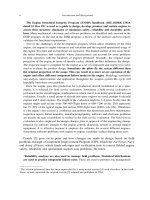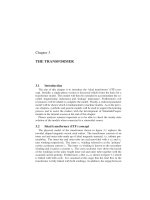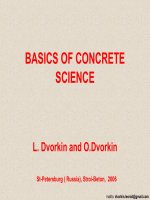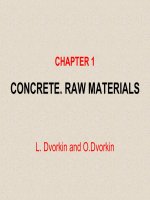BASICS OF CONCRETE SCIENCE - CHAPTER 3 docx
Bạn đang xem bản rút gọn của tài liệu. Xem và tải ngay bản đầy đủ của tài liệu tại đây (746.03 KB, 16 trang )
CHAPTER 3
CONCRETE HARDENING
AND STRUCTURE-FORMING
L. Dvorkin and O.Dvorkin
55
3.1. Hardening and structure of cement stone
Hydration of cement
A chemical process of cement hardening is the processes of hydration which
occurs at mixing cement with water. Composition of new compounds is
determined by chemical nature of waterless compounds, ratio between solid and
liquid phase, temperature conditions.
Concrete hardening includes the complex of processes of cement hydration.
Physical and chemical processes of structure formation of cement paste make
substantial influence on concrete hardening. Concrete hardening and forming of
concrete properties depend greatly on the mixing water, aggregates and
admixtures used.
56
Fig.3.1. Rate of reaction of the calcium hydroxide Ca(OH)
2
forming during hydration of calcium silicates:
1 – tricalcium silicate (3СаО⋅SiO
2
); 2 - β - modification dicalcium
silicate (β- 2CaO⋅SiO
2
); 3 - γ - modification dicalcium silicate
(γ -2CaO⋅SiO
2
)
Quantity of calcium hydroxide, %
Age, days
Fig.3.2. Plane section of
tricalcium silicate (C
3
S) structure
57
High hydration activity of aluminates minerals is caused by possibility of
structural transformations due to the instability of the concentration of Al
3+
ions in the crystalline grate of these minerals.
All clinker minerals are
disposed in a row concordant
with their hydration activity:
tricalcium aluminate (C
3
A) –
tetracalcium aluminoferrite
(C
4
AF) - tricalcium silicate
(C
3
S) - β dicalcium silicate
(β-2CaO⋅SiO
2
).
Fig.3.3. Structure of elementary cell
of crystalline structure
of tricalcium aluminate (C
3
A)
Calcium
Oxygen
Aluminium
58
Fig.3.4. Schematic image of the reactive
with water grain
of tricalcium aluminate (C
3
A):
1- non-hydrated kernel; 2- primary hydrate;
3- second finely
crystalline calcium silicate
hydrate (internal
product); 4- third crystalline
calcium silicate hydrate (external product); 5-
separate large crystals
The rate of reaction between cement and
water is accelerated if there is increasing in
temperature, that is characteristic for all
chemical reactions. Kinetics of hydration of
compounds of portland cement clinker and
their mixture in portland cement is described
by formula:
(3.1) ,ВlgkL
+
τ
=
where the L – level of hydration;
τ – time; k and B – constants.
Level of hydration determines quantity of
cement reacting with water through the
setting time.
59
From positions of the physical and
chemical mechanics P.Rebinder divides
the process of hardening of cement
paste on three stages:
a) Dissolution in water of unsteady
clinker phases and selection of crystals;
b) Formation of coagulate structure of
cement paste;
c) Growth and accretion of crystals.
Fig.3.5. Chart of coagulate
structure of cement paste
(from Y.Bagenov):
1 – grain of cement; 2 - shell; 3 – free
(mobile) water; 4 – entrapped
(immobile) water
Hardening and structure of cement stone
60
Fig.3.6. The simplified model of
structure of cement stone
A cement stone is pierced by
pores by a size from 0.1 to
100 µm.
61
Fig.3.7. Change of capillary porosity in cement paste (stone) in the conditions of
proceeding hydration of cement:
a- Level of hydration = 0.3; b – Level of hydration = 0.7
1- not fully hydrated grain of cement; 2- capillary pores; 3- cement hydrate gel
a
b
62
3.2. Influence of aggregates on forming
of concrete structure
Aggregates along with a cement stone form the concrete structure of
rocklike (conglomerate) mass.
Fig.3.8. Charts of concrete structure:
a –floating structure;
b – intermediate structure; c – contact structure
a
b
c
63
The important structural elements of concrete which determining physical
and mechanical properties are cracks.
In the real material always there is a plenty of microscopic cracks arising
up on technological or operating reasons. Cracks are characterized by a
length, width, radius, and front.
Fig.3.9. Models of cracks:
a – from Griffits; b – from P.Rebinder; c – from G.Bartenev (a, b, c – models of cracks
in ideally easily broken material); d – crack in the real rocklike material (from
G.Bartenev)
a
b
c
d
64
3.3. Influence of admixtures
on concrete structure forming
Influence of chemical admixtures
Fig.3.10. Kinetics of change of level of
hydration of cement silicate phase:
1- without admixtures; 2- calcium nitrite-nitrate
(3%); 3- calcium nitrite-nitrate–chloride (3%);
4- calcium chloride (3%)
Level of hydration, %
Age, days
65
Fig. 3.11. Chart of
molecule of surface-
active substance
CH
2
CH
2
H
2
C
H
2
C
OH
20⋅10
-10
m
1.1⋅10
-10
m
Fig.3.12. Adsorbed layer of
surface-active substance at
the surface of a solid
66
Influence of mineral admixtures
Finely divided mineral admixtures which are either pozzolanic or relatively
inert chemically make active influence on the processes of hardening and
forming of cement stone structure.
Fig.3.13. Change of the quantity of calcium
hydroxide Ca(OH)
2
in solutions containing
metakaoline (finely divided product that results from
burning of kaolin)
days
67
3.4. Optimization of concrete structure
Concrete structure is a cover-up of its structure at a different levels from
atomic - molecular for separate components to macro-structure as
composition material.
Fig.3.14. Kinds of optimization tasks (from V.Voznesensky):
a – achievement of the set level of criterion of efficiency (J) at the minimum expense of
resources; b – achievement of maximal level of criterion of efficiency
at the complete
expense of resources for achievement of purpose
Resource
Resource
a
b
68
Some structural criteria of properties of concrete
Structural criteria Formula Denotations
Density of
concrete (d)
airc
c
VWV
V
d
++
=
V
c
, W ,V
air
- absolute volumes of cement,
water and air in the general volume of
concrete, liters per cubic meter (l/m
3
)
General porosity
of concrete (P
s
)
1000
VC23.0W
P
air
s
+α−
=
C - quantity of cement, kg/m
3
; α - level of
cement hydration
Volume
concentration of
cement paste
(stone) in the
concrete (C
p
)
()
+
ρ
= C/W
1
1000
C
С
c
p
ρ
c
– specific gravity of cement, kg per
cubic liter (generally 3.1); W/C – water –
cement ratio
69
Decision of tasks of concrete structure optimization is possible by
mathematical methods supposing determination and analysis of
mathematical models.
Fig.3.15. Strategy of determination of mathematical model
Formulation of
purpose
Formulation of
hypotheses
Planning of
experiments
Conducting of
experiments
Treatment and
analysis of
experiments
Verification of
rightness of the
formulated
hypotheses
Verification of
terms of
experiments
finish
Finish
Yes Yes
No No
